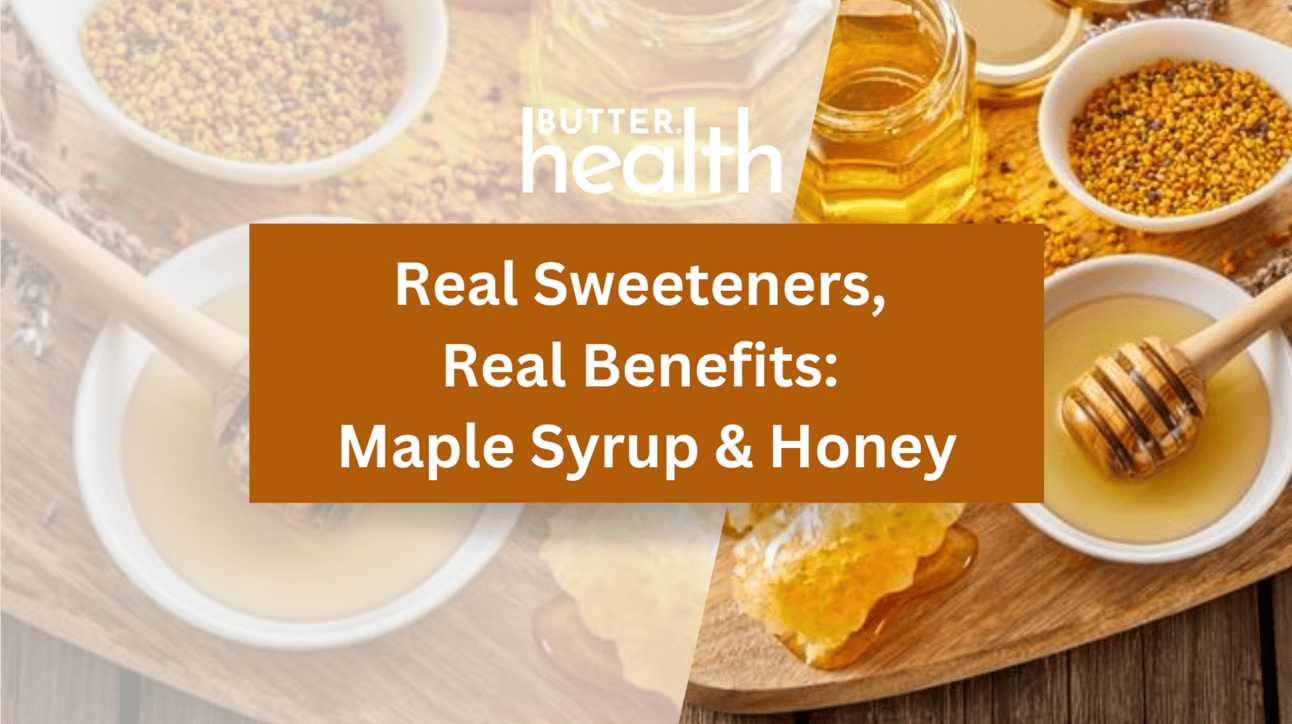- Butter Health
- Posts
- Real Sweeteners, Real Benefits: Maple Syrup & Honey
Real Sweeteners, Real Benefits: Maple Syrup & Honey
Which sweeteners should we be using?

I need a little something sweet with my coffee, drizzled on my yogurt, and stirred into my tea. But plain table sugar? It’s empty calories. That’s why I’m all about pure maple syrup and raw honey. These sweeteners aren’t just tasty. They offer nutrients, antioxidants, gut-loving compounds, and even science-backed blood-sugar benefits. Let’s chat about why they beat sugar, how Scripture calls us to enjoy them wisely, and how you can figure out which sweet fix works best for your body.
Maple Syrup: Nature’s Nutrient Bomb 🍁
Think of maple syrup as more than “liquid candy.” It’s sap from maple trees, gently boiled down until it’s that gorgeous amber color you drizzle on pancakes. Two big perks make me a daily fan:
First, maple syrup contains special polyphenols—plant compounds that actually help your body manage sugar. Studies show these polyphenols can soften the usual blood-sugar spike you’d get from table sugar and even improve insulin sensitivity over time. In other words, your body handles it more gracefully.
Second, those same polyphenols feed the good bacteria in your gut and crowd out the inflammatory microbes that make you feel bloated or sluggish. Plus, two tablespoons of real maple syrup deliver about 35 percent of your daily manganese (a key antioxidant helper), along with riboflavin, copper, calcium, and potassium. And don’t forget the 100+ other bioactive compounds cheering on your cells against oxidative stress.
Raw Honey: Sweet Medicine from the Hive 🍯
Honey isn’t just sugar from bugs, it’s been nature’s go-to remedy for centuries. When you drizzle raw honey into tea, you’re tapping into:
Enzymes that calm inflammation and support your immune system.
Flavonoids and phenolic acids that double as antioxidants.
Trace vitamins, minerals, and even pollen compounds that may ease seasonal allergies.
A spoonful of raw honey isn’t only about sweetness; it’s a little dose of healing.
Other Sweet Players You Might Try 🌿⚪️
If you’re curious beyond maple and honey, here’s a quick look at a few more options:
Stevia & Monk Fruit: Zero calories, no blood-sugar spike, and plant-based. The catch? They can taste a bit bitter or metallic. If you go this route, choose a pure, minimally processed extract and start with a tiny pinch.
Date Syrup: Made by cooking down whole dates, you get fiber, potassium, magnesium, and antioxidants—not just fructose. It’s super sweet, so you need less. Still, treat it like any sugar: a tablespoon or two tops if you’re watching calories.
Allulose: A “rare sugar” that naturally appears in dates, figs, and raisins. It has about 90 percent fewer calories than sugar, barely nudges your glucose or insulin levels, and tastes just like sugar—no weird aftertaste. In larger amounts, it can cause mild bloating, and it’s processed in isolation, so think of it as an occasional treat alongside whole-food sweeteners.
Enjoying Sweetness with Wisdom 🙏
God delights in the good gifts He’s given us—including real, delicious sweetness. But He also calls us to self-control. Even honey gets a “too much” warning in Proverbs:
“If you find honey, eat just enough for you, or you will have your fill of it and vomit.”
—Proverbs 25:16
Loving flavors is fine—gluttony is not. Self-control is a fruit of the Spirit (Galatians 5:22–23), and honoring our bodies is worship (Romans 12:1; 1 Corinthians 6:19–20). So yes, drizzle away! But keep portions sensible and remember that even real food adds up.
Discovering Your Personal Sweet Spot 🔍
We’re all metabolically unique. Some people see a spike from black coffee, while others add a splash of maple syrup and don’t flinch. The best way to know what works for you? Grab a continuous glucose monitor (CGM)—you can get one from HelloLingo.com for around $49. Then run your own test:
Day 1: Start with the sugar you use every day (that heaping spoonful of white sugar in your coffee). Track your blood sugar with a CGM to establish your baseline.
Day 2: Swap in the same amount of pure maple syrup. Note how your glucose curve changes.
Day 3: Stir raw honey into some tea and compare the graph.
Day 4: Try a dash of allulose in your coffee and see what your numbers do.
Watch those CGM trends, then listen to your body—energy levels, cravings, digestion, and mood all matter. That’s how you move from guessing to knowing which sweetener fuels you best.
Make the Swap!
Swapping table sugar for maple syrup and raw honey gives you vitamins, minerals, antioxidants, and prebiotic love that plain sugar can’t touch. Scripture calls us to savor God’s gifts with self-control, and a CGM lets you pair faith with data so you can steward your body wisely.
This week, make one simple swap: drizzle maple syrup or raw honey instead of sugar. Track how you feel, celebrate small wins, and honor your body—the temple God entrusted to you—one sweet spoonful at a time. 🙌
👉 Ready to sweeten your health journey? Schedule a call with me today!
Reply